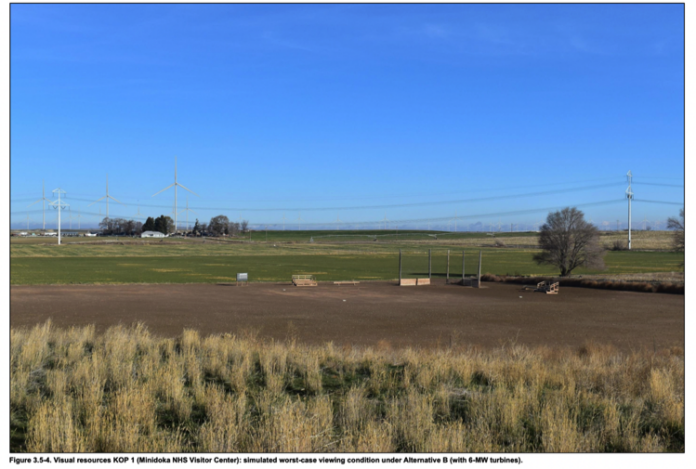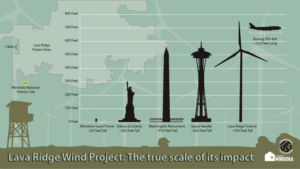
BLM outlines five alternatives to wind project layout, impacts
BY Tristan Head
 Idaho’s Bureau of Land Management recently concluded a commentary period resulting in 11,000 comments regarding a proposal of up to 400 wind turbines spanning nearly 75,000 acres by Magic Valley Energy near Minidoka, potentially powering 350,000 homes in Idaho from the 1,000-megawatt infrastructure, depending on which state purchases the power.
Idaho’s Bureau of Land Management recently concluded a commentary period resulting in 11,000 comments regarding a proposal of up to 400 wind turbines spanning nearly 75,000 acres by Magic Valley Energy near Minidoka, potentially powering 350,000 homes in Idaho from the 1,000-megawatt infrastructure, depending on which state purchases the power.
The BLM developed a nearly 600-page Draft Environmental Impact Statement (DEIS) outlining five alternatives to not only the layout, but the impact resulting in as many as 486, or as little as 270, miles of newly developed roads on BLM land impacting flora, fauna, and humans alike (DEIS, 58). While citizens of the United States agree sustainable energy is a necessity to curb climate change, it forces individuals to contemplate: How can we evaluate sacrifices required to achieve this objective by 2030?
Idaho Attorney General Raúl Labrador and Representative Dorothy Moon have both emphasized the “harm to people” of Idaho due to the influx of labor from the Lava Ridge Wind Project, resulting in labor and housing shortages. Rep. Moon emphasized, “…the Magic Valley housing market will see a sudden influx of out-of-state laborers, many of them without lawful status to work in the U.S.” The Magic Valley experienced a growth of 16.1% between the 2010 and 2020 Census, conveying the inevitable growth of southern Idaho, but the DEIS contrasts these statements by showing “…there is adequate housing for short-term residents across the Magic Valley to support non-local workers.”
“The Lava Ridge project will prioritize hiring local contractors and individuals for the construction phase. Certain groups of qualified workers are likely to come from outside the immediate area.”said Amy Schutte, press spokesperson for Magic Valley Energy. With the growth of College of Southern Idaho’s Renewable Energy Systems Technology Program, local students will benefit, since “Magic Valley Energy plans to support local workforce development and educational programs, particularly those that offer pathways to a career in the rapidly expanding energy industry.” With an additional “economic impact report done on the project, more than $80 million will be realized in tax revenue for the State of Idaho, while the region will benefit from more than $500 million in economic output.”
Idaho Senator Ron Taylor (D-Dist. 26) emphasizes another concern to humans: “If you’ve ever fished at Silver Creek, by Picabo, and looked out across the fields and said, ‘Wow, this is absolutely phenomenal’ — that will go away,” Taylor said. “You will be able to see some of these wind turbines while you’re fly fishing.” Yet, Amy Schutte, press spokesperson for Magic Valley Energy, explained a vital point found within the DEIS, “The agency’s visual analysis shows the project will have no visual impact to Silver Creek.”
Another vocal opponent of the visibility and proximity of the project is the Friends of Minidoka, whose official statement included, “… Lava Ridge wind project will forever alter Minidoka’s somber landscape and fails to honor the significance of the events that occurred at Minidoka as a place of reflection, healing, and education for the survivors, descendants, and public. The proposed project places 340 towers in the Minidoka NHS viewshed with 12 of those towers on the historic Minidoka footprint…”
While nearly impossible to measure the impact the project could have on survivors and descendants of Minidoka National Historic Site, in addition to Indigenous tribes whose roots stretch back thousands of years, the BLM did “put forth two preferred alternatives for the Lava Ridge Wind Project that scaled the original project proposal back to align with cultural, community, and wildlife needs, including thoughtful setbacks from the Minidoka National Historic Site to site turbines five to 10 miles away.”
Southern Idaho has been “losing 1.3 million acres of sagebrush habitat per year to conifer expansion, invasive annual grass invasion, and land-use conversion.” This in turn mirrors A.G. Raúl Labrador’s comment that the wind farm will “remove or alter wetlands, change their function, change the rate and quantity of runoff, compact soils, and alter flow patterns,” while Schutte emphasized “The project will have no impact on the aquifer or Idaho’s groundwater.”
Labrador also references estimates of 10,000 bats and birds being “pulverized” per year, yet the BLM’s DEIS study found that “wind energy’s avian fatality estimate is roughly half that of nuclear energy and almost 20 times smaller than traditional fossil fuels,” equaling less than one bird per gigawatt hour compared to traditional fossil fuels, which is five birds per gigawatt hour. Certain scaffolding techniques applied to the windmill layout should mitigate the impact on raptors, but local farmer Dean Dimond’s fear should be noted, “about every third or fourth year we get hit with a vole infestation that the birds of prey help alleviate.”
The Biden Administration invested an astounding $370 billion into renewable energy, striving for electricity to be 100% carbon-free by 2035 (White House). This inevitably will require sacrifice not just from citizens of the United States in general, but specifically Idaho. While Idaho representatives actively speak up for their voters and the flora and fauna falling within their districts, these comments must consider all aspects and not just sustainable energy resulting in a net positive for the environment determined by stakeholders, the Idaho citizen. Part of the role of a democratic society is being an informed voter, so voters are encouraged to stay up-to-date as the BLM strives to make a choice by the end of the 2023. The preferred alternatives demonstrate how public engagement has refined and created a compromise by all sides.


